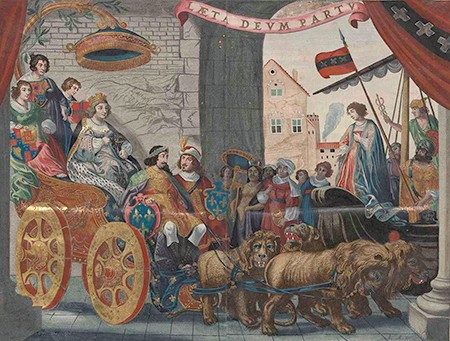Marie de’ Medici (1573–1642) visited Amsterdam in September 1638, after spending seven years in exile as the result of a dispute with her son Louis XIII (1601–1643). As the former queen regent of France (1610–1614), however, she was the first royal figure who personally visited and thus explicitly acknowledged the Dutch Republic as a sovereign country. The circumstances and conditions of this first state visit were nonetheless controversial, and the States General of the republic warned its cities not to support the former queen at the state’s expense. Given these instructions and the precarious position of the guest, the splendor with which she was welcomed in Amsterdam was astonishing. Ephemeral triumphal arches with tableaux vivants decorated Marie’s processional entry into the city, and she was escorted by civic militia companies, both mounted and on foot. A floating theater erected in the Rokin staged additional tableaux on the third day of her visit, and she was treated to an elaborate banquet of products from the East Indies as well as to tours of the city.
During my CASVA fellowship I have worked toward completing a draft of my dissertation, which examines the decorative programs designed for such ceremonial receptions in Amsterdam during the first eight decades of the Dutch Republic (1580–1660). My dissertation constructs an understanding of their (political) purpose and impact through evidence found in the surviving archival documents and printed materials that celebrated and memorialized them, ranging from elaborately illustrated festival books to cheap prints and songbooks marketed to broad audiences. I argue that the Dutch ceremonial entries, as republican adaptations of the monarchical joyeuse entrée and triumphal entry formats, took shape at the intersections of inherited traditions of monarchy and contemporary developments in Dutch republican politics and visual culture, particularly those offered by Amsterdam’s booming art and information markets. As such, these receptions and their representation in print not only functioned as platforms for emerging political and social hierarchies but also employed various media, such as painting, print, performance, poetry, and music, to help construct and negotiate those hierarchies.
A tableau vivant performed for Marie de’ Medici on the day of her entry, for instance, represented her as the mythical Mother of Gods Berecynthia (Cybele), accompanied by her children in a triumphal chariot drawn by lions. The theme was meant to underscore not only Marie’s continued relevance and political influence as matriarch of a European royal dynasty but also to represent a symbolic meeting—and radical equality—between the queen and the Dutch capital of international trade. As a mirror image to the Berecynthia scene, a cog ship carrying a personification of Amsterdam was placed on the opposite side of the stage. Its emphasis on the city’s identity as a global mercantile power is particularly visible in an illustration of the scene by Pieter Nolpe (1613/1614–1652/1653) after designs by Claes Moeyaert (1591–1655) found in Caspar Barlaeus’s Medicea Hospes (1638; Dutch and French editions, 1639). Instead of placing personifications of the four continents surrounding Berecynthia’s chariot, as described in the text, Moeyaert shows them to the side of the Amsterdam cog, signaling the city’s status as an international trading nation. The placement of chariot and ship on the same level furthermore provides a visual equivalency between the two figures that prompts a direct comparison. That the city regents formed a particularly eager audience for Barlaeus’s book is evidenced by their recorded ownership of customized copies of the Dutch edition, featuring hand-colored prints, as well as large-format copies with additional inserted prints.
In four chronologically ordered chapters, my dissertation traces the adaptation of this historic ceremonial tradition in the interpretive contexts of Amsterdam’s quickly expanding urban fabric, cultural networks, and lively print culture. I reconstruct processional routes and sites of importance from festival publications, unpublished accounts, and archival records, such as decrees (keuren). At the same time, I examine the city’s patronage of the festivities through commissions recorded in city ledgers (stadsrekeningen) and correspondence, as well as poems and their dedications. I analyze richly illustrated festival books, such as Medicea Hospes, as mnemonic agents that represent the ceremony in constructed and idealized fashion, but I also utilize cheap prints and pamphlets responding to the festivities in order to provide a “bottom-up” investigation of their popular reception. The ceremonial format of the joyous entry procession in these contexts, I find, was innovatively utilized both to formulate arguments for Dutch sovereignty and to bestow traditional notions of royalty and status associated with such events on a new order of recipients—including Amsterdam’s ruling class of merchants.
